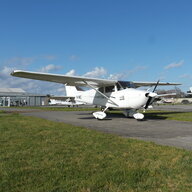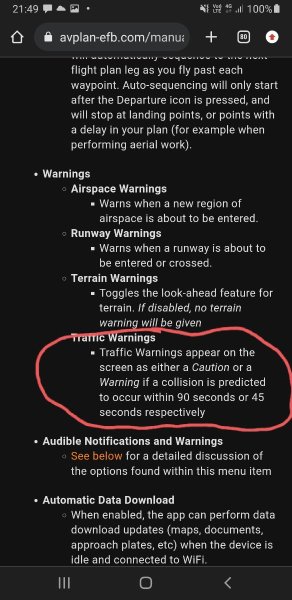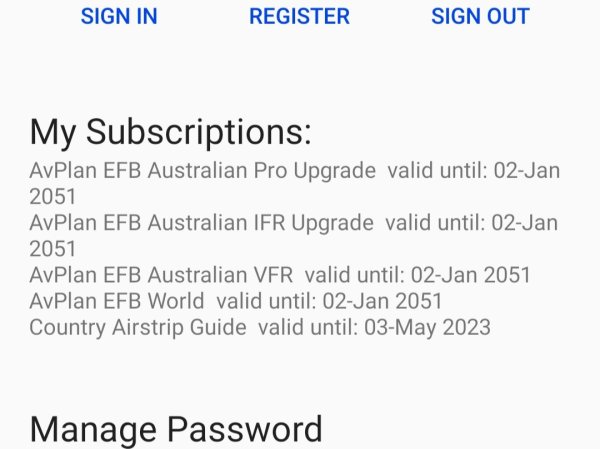-
Posts
401 -
Joined
-
Last visited
-
Days Won
1
Content Type
Profiles
Forums
Gallery
Downloads
Blogs
Events
Store
Aircraft
Resources
Tutorials
Articles
Classifieds
Movies
Books
Community Map
Quizzes
Videos Directory
Posts posted by Bosi72
-
-
That would be great to have, especially for airshows, or aircrafts operating in aerobatic areas, where paths are based on aerobatic sequences.
Just as an example, below is the path of Extra NG operating in various directions both vertically and laterally, in a short period of time, within 1km x 1km x 1km box, between 3000ft and 1500ft, and speeds between 250kt and 60kt.
https://flightaware.com/live/flight/map/VHOPK/history/20221203/0129Z/
There is a software which does that, embedded in air-air missiles, however even that software has misses.
Personally, proximity alert is good enough for me to start thinking what to do next.
Look forward to see the development of the trajectory projection app.
-
 1
1
-
-
-
Welcome to the forum Dermott McD, lots of stereotypes for your first post ever. A number of people on this forum fly both powered and unpowered aircrafts, so comments about radio calls of one group vs another doesn't make sense.
Regardless, the fact is there are about 6% of gliders based on information from VH and RAA registers. Flying hours wise, the percentage is significantly less, therefore it is not realistic to expect that 94% of powered world would switch to FLARM.
I suggest that gliding community takes an opportunity to get government subsidised ADSB/out devices.
-
 2
2
-
 1
1
-
-
23 hours ago, johnm said:
Danny, she wasn't a cop, she was only playing at being one. She was a county official, essentially a ranger, as Dan says, "equivalent to a dog catcher".
'similar to an animal control officer' ...................... please 😇
or Animal Management Officer 🙂
https://www.seek.com.au/job/59319457?
interestingly, earns more than average G3 flying instructor
-
 1
1
-
-
What happened, or what is happening to LPG/LNG ? We may not be rich in oils, but we have large amount of gas, here in Victoria.
My other car is LPG-only Commodore and I noticed they have closed LPG bowsers at 2 out of 4 local petrol stations.
The problem is they simply close the tap without providing an alternative. None of those stations have electric chargers.
-
 1
1
-
 1
1
-
-
"There Isn’t a Man Alive Who Hasn’t Made a Mistake" - Bob Hoover
-
16 hours ago, spenaroo said:
don't want to be age'ist....
but I think its time to look at the age of these pilots.a lot of these pilots are in their 70's flying high performance aircraft in an increased danger environment.
maybe its time to say display flights are to be done by pilots that meet a commercial qualifications (which immediately excludes anyone over 65)
especially with passenger flights.I frequently go hunting in Victorian high country with a father of a friend who is 70yo. Climbing mountains, crossing rivers, gulleys, I only wish I am that fit and vital when I'm in 70s...
On the other side when I'm in Tullamarine watching some chubby/fatty airline captains walking on the terminal, I wonder how they got class 1 medical..
Do not judge people by age and appearance..
-
 2
2
-
 4
4
-
-
6 minutes ago, Kyle Communications said:
"
As for the frequency/SkyEcho, FLARM uses the 'ISM' band (https://en.wikipedia.org/wiki/ISM_radio_band), which is a general-purpose unlicensed radio band allocated by the ITU, unfortunately the ITU allocated a different frequency range in AU/US to Europe.
uAvionix will have to explain whether it's a legal issue or a hardware issue as to why the SkyEcho can't receive the ISM band in Australia (915Mhz). If that could be solved it would be great."
It would be a hardware issue maybe thats why as soon as you select australia it will turn off the FLARM in the SE2
868mhz is not that far away from 915 but the antenna on the internal PCB is made for 868 so it would have a big mismatch
The RF chip nowdays will do the full frequency range but it would be the microstrip antenna
Most likely a new antenna and it would work fine but Australia is a small market so it would require different hardware version
email from uavionix tech
***
Australia, US & Canada are using a transmission technique called "Frequency Hopping Spread Spectrum" (FHSS).In UK/EU FLARM is centred on 868.2 MHz and does not use FHSS. This means that the second SkyEcho receiver can be offset from its designed 978MHz to 868.2 MHz to enable UK FLARM reception instead of UAT. This is not feasible in Australia because of FHSS (the frequency is changing at a pseudo random rate) and SkyEcho is not capable of following it. We therefore cannot offer FLARM reception on the Australian frequencies.
***-
 2
2
-
-
10 hours ago, plantain said:
Some background on why gliders (have to) use FLARM:
We have been using FLARM in gliding since ~2005, and it is mandatory at all contests/regattas and even mandatory in some countries or clubs. Almost every glider in Australia has had one for more than a decade now. It's very entrenched.
When gliders are soaring we are looking for thermals, and when one glider finds a thermal the surrounding gliders will want to use the same thermal rather than trying to find their own and risking outlanding.
This naturally brings gliders together very frequently, and it is quite common to fly an entire flight in close proximity (<1km) from your friends. This is practiced and trained for and generally a non-issue because they are highly manouverable with good visibility, but very occasionally pilots get it wrong.
A naive collision detection system would alert non-stop in a situation with so many aircraft in close proximity. FLARM has patented a number of algorithms such that their collision detection system understands the movement of gliders in thermals such that it will only alarm when the pilots have missed each other and are actually likely to collide.
So I'm afraid we can't just get rid of FLARMs and change to ADS-B, as it simply won't function to help prevent collisions between gliders, of which the risk of collision is much much higher than to any other aircraft.
As for the frequency/SkyEcho, FLARM uses the 'ISM' band (https://en.wikipedia.org/wiki/ISM_radio_band), which is a general-purpose unlicensed radio band allocated by the ITU, unfortunately the ITU allocated a different frequency range in AU/US to Europe.
uAvionix will have to explain whether it's a legal issue or a hardware issue as to why the SkyEcho can't receive the ISM band in Australia (915Mhz). If that could be solved it would be great.
There is hope though, more modern FLARM's can have ADS-B IN, and we then see power aircraft with ADS-B OUT on our instruments.
Some pilots especially in busy areas are now fitting SkyEcho's to their gliders using the grant scheme, but they are unlikely to have alarms or displays showing power aircraft due to space and excessive alarming (from other glider) concerns. Glider cockpits are small and we can't just add another iPad.
A very few ultra-modern gliders have certified transponders with ADS-B OUT - until recently the power consumption of transponders/ADS-B was too high for gliders running off battery power only. Transponders are generally prohibitively expensive to retrofit relative to the cost of most gliders, even with the rebate. Most gliders are only worth ~20,000$.
On glider radios:
Gliders by and large have the exact same radios as RAAUS aircraft, there's no reason for them to be any better or worse. Often gliders flying with their friends in Class G airspace (where gliders largely operate) will be listening on one of the allocated gliding frequencies, so you may not be able to reach them on the area frequency.
Glider pilots have to hold a radio operator licence same as all pilots, and have to have biannual flight reviews where this should be checked. Of course there are still bad apples who don't do the right thing, but it's not as though glider pilots are unlicensed cowboys talking into tin cans.
Welcome to the forum Plantan,
From wikipedia: FLARM is proprietary electronic system used to selectively alert pilots to potential collisions between aircraft. It is not formally an implementation of ADS-B, as it is optimized for the specific needs of light aircraft, not for long-range communication or ATC interaction. FLARM is a portmanteau of "flight" and "alarm".
Certainly over the time, a number of tools, competition applications were developed based on data coming from GPS receiver built within FLARM devices, e.g. if a glider changes an altitude in short period of time, then it must be in thermal, etc.. and thats all fine.
However my problem is in word "proprietary", meaning only FLARM company has legal rights to communication protocol between devices, unless we pay for the licence. I am not interested whether glider is in thermals or whatever specific information is relevant to gliders, but I am interested in basic GPS data.
I don't think any of 10's of thousands of powered aircrafts both private and commercials, plus very soon a large number of UAV's, drones around the world will be installing FLARM devices to avoid gliders.
Unfortunately, I have received an email confirmation that SkyEcho2 cannot receive Australian FLARM frequencies due to hardware limitations.
-
 1
1
-
-
3 hours ago, Blueadventures said:
Must only be an update or 2 away with ozr.
I don't think they care..
When I started flying, I initially inclined towards OzR due to pilot friends and some videos where airline pilots using OzR..
I installed both OzR and AvP at the same time and gave them a month of trial period to see which one suits me more. They both performed well, had almost the same functionalities, however there was one small thing that annoyed me with OzR: icons of other adsb traffics.
They appeared as clouds (they called it bubbles) in OzR whilst AvP had pointy triangles, which were more intuitive to me. I sent an email to OzR support asking if the icons could be customised, but got response sorry this is it..
And my lifetime decision was made..
so far so good..
-
 2
2
-
-
9 minutes ago, kgwilson said:
I don't know the cost of the FLARM licence but they did it for SE2in Europe & Avplan has it so it can't be that expensive.
It is a matter of principles. You can see basic traffic positions for free on FlightRadar24, FlightAware, etc.. however if you want to see other data then subscribe, which is fair enough..
With FLARM it is all or nothing.
-
 1
1
-
 1
1
-
-
I think it is a bit selfish that Gliding community is interested only in their local traffic. Of course they will know every time when their gliders are in the air and FLARM will tell them that too. However it won't tell them anything about rest of aviation flying ADSB.
I am always extra alerted when crossing hills towards YLEG, YBSS, Benalla .. but it would be more safer to "see" them in advance..
-
 2
2
-
 1
1
-
-
4 minutes ago, kgwilson said:
The government should instruct CASA to work with Uavionix and fast track approval for the Australian FLARM frequency to be included in a Firmware upgrade. That is far simpler and would be considerably cheaper.
The problem is FLARM protocol is privately owned intellectual property and you have to pay subscription licence to be able to "listen" the data.
This kind of goes against gliding philosophy with low-cost/low-footprint/low-everything..
-
 1
1
-
 2
2
-
-
Maybe gliding community should switch to open ADSB instead of licence based FLARM ?
Something to discuss between RAA and GFA.
-
 2
2
-
-
10 hours ago, jackc said:
Not to mention FLARM and ADS-B don’t work together in Australia where in Europe they do?
Also, nearly all gliders are primarily white in colour, sometimes rather hard to see……
FLARM operates on a different frequencies from ADSB everywhere in the World, however they(FLARM) have proprietary encryption system which makes them visible only to other FLARM devices, unless they give you the encryption keys.
I can only assume a politics(and $$) as reasons behind as to why can't we see the gliders in Australia on Skyecho2 devices.
Skyecho2 is capable of receiving FLARM, but that option is grayed. A simple firmware update could enable this functionality.
-
 1
1
-
 2
2
-
-
-
 2
2
-
-
The key recommendation is the "Standard overhead join", as per 013/22.
-
On 05/11/2022 at 9:54 AM, hkaneshiro said:
So I have spent a bit too much during my RPL and am thinking that I needed to save some dosh going forward.
Would it be possible to do the following
1. Join RAA and get the RPC conversion from the RPL (5 hours I believe - I wanted to also do it in a taildragger to get a new endorsement)
2. Get X-Country Nav under my RPC
3. Then add the RAA/RPC taildragger+X-country Navs to my RPL
i guess the difference here is that I never did an initial RPC-> RPL conversion with that CASA form. Does this change anything or can I add some of the RPC endorsements added to my RPL later? I could not find a special form.
#1 doable, but you may need to travel further to find RAA taildragger available for training. Taildragger hiring rates are usually around 10-20% more expensive than nose wheels.
#2 that will be additional 20 hours for Nav endorsement + theory exam.
#3 may be tricky unless you find an RAA taildragger with VH rego since CASA require all flight tests to be done in VH aircraft.
If #3 is your end goal, maybe PPL->RPC path would be a better option?
Providing the school is both GA and RAA, they will be able to answer all your questions.
-
-
On 19/10/2022 at 6:33 PM, APenNameAndThatA said:
This might save someone about $600.
I tried several options as spending close to $2k on headsets didn't make sense, but I still ended up buying A20.
Had I bought A20s as my first and only headsets, I would save $.
To my comfort, I keep DC's as spare or pax headsets.
-
 1
1
-
-
10 hours ago, skippydiesel said:
This is in-itself part of the problem. I refer to the unstoppable march of technology. Don't get me wrong, technology enables me to fly etc etc not against it, just recognise that so often (always?) there is a down side, rarely considered , to every "improvement/enhancement".
In this case the dumbing down of driver skills.
and I agree..
My '17 Colorado is manual and it came from factory with the sway control, ie. it wasn't optional. Regardless I've never felt nor experienced the trailer control system kicking in although I travelled half a continent towing a trailer.
However, last week I hired a new Ranger and must admit the "lane departure" feature was scary when fighting the steering wheel. On top of it I didn't like the delay in "engine stop start" feature, but thankfully there's a button to turn it off.
Apparently that's the present/future..
-
 1
1
-
-
I wouldn't worry too much with dual axle trailer loaded at 150kg.
Also, a number of 4wd's, utes and cars these days have a trailer sway control.
-
Last weekend I helped lifting an Auster onto a long 2-axle flat trailer with wings on the floor (under the aircraft belly).
Lots of cushioning, pillows, mats, straps, card boxes, and bits&pieces that went into the van.
Way cheaper than 15k truck. Unfortunately, the Spirit was always expensive and I'm yet to bring my camper trailer on the Spirit.
Alternatively, wait for High pressure system over the Bass strait, then fly to Tassie. Stop at Yarram for fuel. Climb to 7500ft and you will clearly see the Flinders Island shortly after takeoff.
Check Ersa SP1..
-
 1
1
-
-
On 08/10/2022 at 11:19 PM, Shu_downunder said:
I've just started training and been dreaming to own a 4-6 seats light airplane, hopefully in the near future.
Can anyone give me some idea where should I look for source for hangars?I live in North-east of Melbourne, between ESSENDON and Lilydale.
Where are you doing flying training and in which aircraft? That information may give you the answers to the questions.
-
 1
1
-





RPC flight test checkride - what does it involve?
in Student Pilot & Further Learning
Posted
I am yet to hear someone robbed the school and took all logbooks, or all school logbooks consumed in fire, or...
Regardless, if any of above happens, it will be a new logbook with a statutory declaration, cross checked with both school and CASA records (providing they survived too)
At the end of the day, all flying is competency based, so number of hours is more about approximations, rather than exact numbers, eg. if you are applying for an airliner job, your sim performance will be more important than 1500 hours bashed in C172, etc..
But yeah, it feels better when the logbook is on a personal bookshelf, rather than elsewhere..